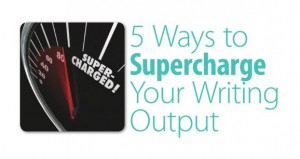If you’ve been waiting for the perfect opportunity to align your writing ambition with a robust income, you’re going to like what we’re highlighting today.
It involves the best of the Barefoot Writing World: Big writing goals, serious earning potential, and a second income stream.
You can enjoy these benefits whether you decide to focus on copywriting, web writing, social media campaigns, email newsletters, or any of the other writing opportunities we’ve shared with you.
That’s because it’s something you can do on the side, in your spare time – though it can also be your main focus, if you choose.
We want you to know about it because a lot of Barefoot Writers – myself included – hope to someday write a book (or books) about topics that fascinate us.
But two things hold us back from achieving that goal. For starters, writing a book is a major undertaking that requires a ton of time upfront before you enjoy any kind of reward.
Second, there’s the risk that you won’t get much of a payoff at the end.
And who wants to pour their heart-and-soul into a major project, only to discover nobody wants to read it?
That’s exactly how I felt until I discovered that, yes, you really can make money writing e-books!
According to author and copywriting legend Bob Bly, this opportunity could earn you as much as $200,000 in passive income in 12 to 24 months.
Let me repeat that – passive income, which is income you can make while you’re playing, sleeping or working on other projects.
It all starts with writing and publishing your own e-books. Read on to learn how you’re just four steps away from watching your writing career balloon with income and freedom.
Why E-Books Outperform Traditional Paper Books
One of the advantages to writing e-books for profit is that there are minimal start-up costs, but a huge potential payout. When you first begin, all you’ll pay is the price of a domain name and a hosting account. Unlike a brick and mortar store, you don’t have to stockpile inventory or pay fulfillment expenses.
This is also a better deal in the long run than taking the traditional, paper-printing route. If you were to self-publish a traditional paper book, you’d likely pay between several hundred to several thousand dollars in printing costs. Then you’d need to store the books somewhere while you wait for orders to come in. Once you get orders, you’d have postage and packaging expenses.
But with e-books, you skip all these steps – yet you still get to call yourself a published author.
It also works out to be a better deal than striking an agreement with a major publishing house. For starters, your profit margin with e-books is between 70% and 100%. This contrasts sharply with the traditional publishing industry standard of 7% – 13%.
And the strange (but cool) thing is, e-books have a higher perceived value than regular books so you can charge more for the same amount of content.
You’ll also get your book published and for sale a lot faster than you would if you waited to strike a publishing deal. Once written, you can have your novel or nonfiction e-book uploaded and ready for sale in two weeks or less. Traditional book publishers sometimes take as long as three years to get your book out on shelves.
Plus, know that e-book writing success is unlimited when it comes to topics. Whether you want to write fiction or nonfiction, a cookbook or how-to guides, e-books are the way to go if you dream of getting published and making money from your content.
One Hour a Week for a MASSIVE Payoff
As you can see, you really can make money writing e-books for a lot of reasons. But you should know that there is work involved upfront. For example, when you first get started, you’ll need to devote several hours a week to actually writing your e-books. Then, you’ll need time to write the copy for your website that will connect potential buyers with your e-book.
Once your e-book business is up and running, you can literally devote as little as one hour each week to maintaining your relationship with customers. That might include writing additional copy to attract new buyers, putting together emails to send to your existing list of buyers, or updating and writing new e-books.
After you’ve taken those steps, you’ll be well-poised for success. Because along with building your own list of customers through a dedicated website, you can take advantage of the incredible readership on Amazon.com and other online reading platforms.
Your 4-Step Plan to Getting Started as a Money-Making E-Book Author
STEP 1: What would you most LOVE to write about?
The first step is pretty straightforward: Choose a topic. You absolutely want to come up with something you’ll love writing about (remember, Barefoot Writing shouldn’t feel like work!).
If you have trouble deciding, don’t hem and haw about it. Make a list of your hobbies or topics you discuss with your friends. Then, narrow it down to the top five. You can always write an e-book on one subject and then switch topics down the road. Celebrated copywriter Bob Bly has e-books on everything from writing to raising children to car tips.
One proven way to get started is to write about something you know about, or to pick a topic that focuses on something you most want to learn about.
If you’ve already got some writing projects in your portfolio, look at whether you can repackage them into new content. Comb through your writing archives and see what’s there. You might be surprised to find files with existing content you can use.
In fact, if you do writing work for clients, this is another reason to write in a niche you enjoy. As you build your client base and earn regular income, you’ll also be building your knowledge base and copy archives for projects like e-books.
On the other hand, if you don’t have pre-written content, or you’d like to focus on an entirely new topic, then go for it – don’t hesitate.
STEP 2: Use your Barefoot Writing skills to spread the word
The reason e-books are such a great Barefoot Writing Opportunity is because there’s legitimate money-making potential.
Assuming you choose a topic that even a small subset of other people are interested in … and let’s be honest, there’s typically a crowd of interest for virtually every topic under the sun … then your next task is to get the word out to those people. Which means you’ll need to put together a funnel that tells them about it, and persuasive writing – i.e., copywriting – is the most effective way to do that.
The easiest way to get started is with a website dedicated to your topic. Fill it with copy that lets people know you have an information-packed e-book available. Make sure to tell your readers what’s in it for them. In other words, highlight the benefits your e-book provides.
You could even offer an email newsletter through your website that continuously shares information related to your topic, and occasionally reminds people about the e-book you wrote.
STEP 3: Remove all obstacles: Outsource!
Here’s what NOT to do when you write your e-book: Don’t waste your time on the technical side of e-book creation.
I’m talking about creating the actual e-book from the content you’ve put together, as well as putting up your website and getting payment options set up.
If you have some experience in coding or you’ve set up shopping cart systems before, you might consider doing it yourself. But otherwise it’s a no-brainer: Outsource it.
Your goal is to be a professional, expert writer. So, you should focus on the creative side, which is where you make your money, instead of getting hung up on technical details like designing a book cover or figuring out how to handle credit card transactions.
As a freelancer, you also have the responsibility to pay it forward. We want and expect others to hire and pay us for our skills. So, it makes sense for you to consult a graphic designer or website builder when it comes time to launch your own writing ventures.
Plus, it’s too easy to let your initial writing goals lapse when you get caught up in the technical side of things.
STEP 4: Sell. Make a profit. And keep earning for years to come!
There’s one final thing you need to know about how to make a profit off e-books and keep earning for years to come.
It boils down to a single, key thing: Consistency. Once you’ve done the upfront work, you need to devote roughly one hour a week to maintaining your earnings.
Now, let’s recap the process:
First you launch your e-book project. Pick your topic and write your e-book or e-books.
Then you’ll set up your website and write sales copy. You also need to write persuasive copy that drives people to your site, whether it’s in the form of emails, online ads, social media posts, or blogs.
Part of the reason you drive people to your site is to get them to opt-in to your mailing list to receive more information about your e-books. As your mailing list grows, your number of potential buyers increases.
Over time, that number has to be maintained. So you need to continually publish copy that gets new names on your list. And you’ll want to update and add to the e-book content you offer for sale.
But you know what? It doesn’t take a lot of effort once you get the ball rolling. Like I mentioned before, it averages out to about an hour a week – and that number comes from Bob Bly, who’s been making a passive income off e-books for years.
Take the Leap and Become a Money-Making Author Today
Writing copy for paying clients is fabulous – and by all means, continue to pursue that. But if you can have a six-figure passive income rolling in on top of that? Wow.
If you haven’t yet, spend some time thinking about the ideal e-book topic for you – and then go for it! Every success story I’ve ever read about a high-profit e-book starts with a writer who took a risk, did the writing, and put the e-book out there.
Editor’s Note: If you’d like to learn more about how to write, how much to charge, and how to market your e-book effectively, take a look at Bob’s Bly’s Ultimate Guide to E-Book Writing Success.






